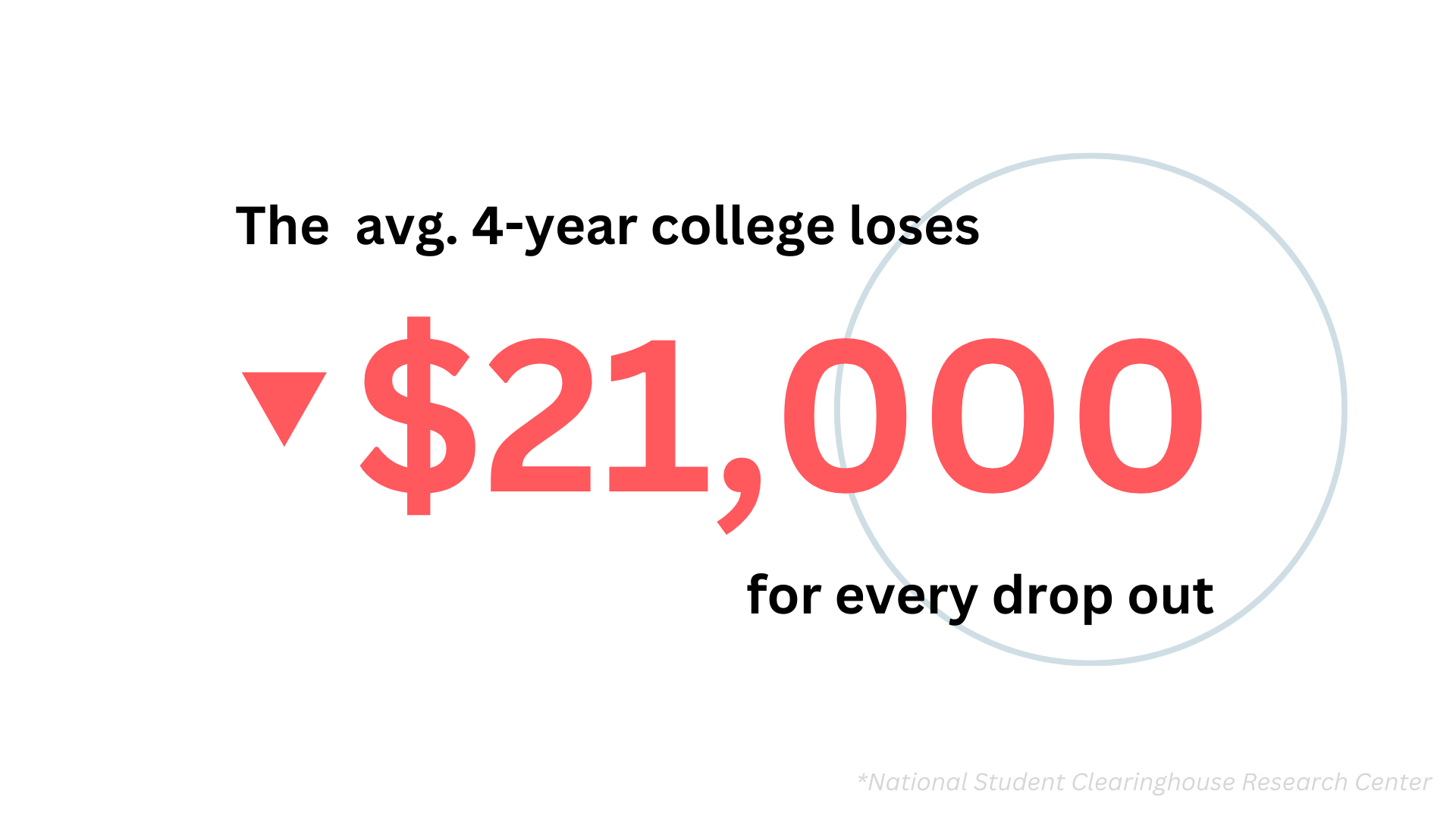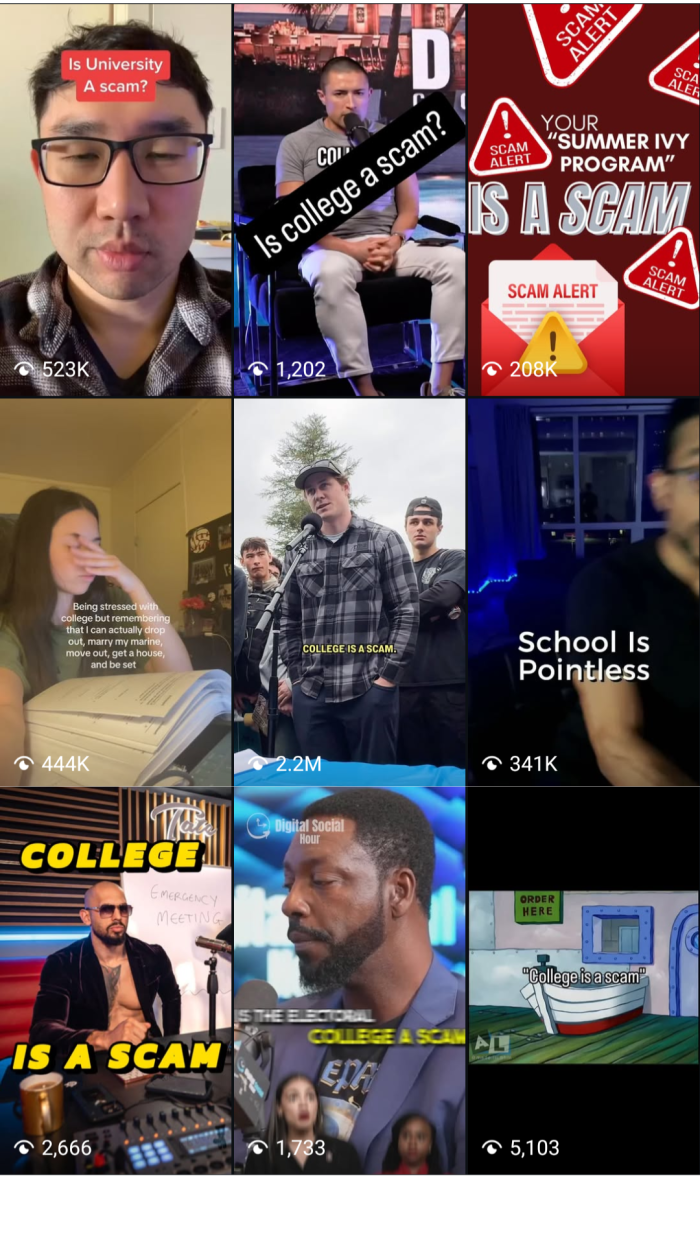
The Harsh Costs of Low Retention in Higher Education
The number one problem we encounter when working with higher education institutions is student retention.
Every student who drops out risks long-term financial hardship, earning 35% less annually on average than if they had graduated. For institutions, each student who quits represents thousands of dollars in lost revenue, lower rankings, and challenges in faculty recruitment and funding. And for our society, every student who quits is another person with less education, fewer skills, and potentially less capability to stimulate the economy and contribute productively.
Poor student retention really is the ultimate higher education lose-lose-lose.
On the flipside, student retention is the number one defining factor in the success of higher education institutions. It not only reflects an institution’s ability to support students through to graduation, but high retention rates also bolster an institution’s financial health and reputation.
So, what is the extent of our contemporary retention problems? How much are these issues actually costing institutions? And how do we make a change?
Estimated reading time: 7 minutes
The Scope of the Student Retention Problem
Recent data from the Education Data Initiative indicates that 39% of first-time, full-time bachelor’s degree-seeking students do not complete their degree program within eight years due to withdrawal. Well over a third of all incoming students are leaving before earning a degree.
The issue is particularly pronounced among first-year students. At two-year institutions, 37.1% of first-time, full-time freshmen drop out of college. Four-year institutions experience a wider variety of first-year retention, ranging from 18.6% at private non-profit institutions and up to 38% at private for-profit institutions.
The retention crisis also disproportionately affects certain demographics. In the United States, American Indian/Alaska Native students have the highest average dropout rate at around 40%, followed closely by Black and Pacific Islander students. Meanwhile, Asian and White students tend to persist at low dropout rates, highlighting disparities in college preparedness, financial support, and institutional resources.
The overall timeline of higher education has shown a very slight increase in student retention over the past decade, however, that is part of a larger ebb and flow that persists at an alarmingly low mean. It seems that no one has truly “cracked the code” on the retention issue.

The Costs and Consequences of Low Retention
Low student retention isn’t just a challenge—it’s a costly crisis. When students drop out, the financial, reputational, and academic consequences ripple across entire campuses, affecting students, faculty, and administrators alike.
1. Finances
Higher education institutions depend on tuition and fees to maintain operations, fund academic programs, and provide essential student services. When students leave before completing their degrees, colleges and universities lose substantial revenue. According to the National Student Clearinghouse Research Center, the average community college loses $10,000 per dropout in tuition and fees, while four-year institutions lose $21,000 per student.

For a university with 10,000 students and a 10% dropout rate, this translates to a staggering $1–2 million in lost revenue annually—funds that could have been reinvested into faculty hiring, academic resources, and student support services. Budget shortfalls caused by low retention can lead to:
- Cuts to faculty positions and research funding
- Fewer scholarships and student services
- Reduced campus resources and program offerings
2. Reputation & Rankings
Universities with high dropout rates also struggle to maintain prestige and attract top students and faculty. Retention rates are a key metric in college rankings, meaning institutions with high attrition often face declining enrollment. A lower ranking makes it more difficult to recruit high-achieving applicants, secure research grants, and maintain high-quality faculty.
In addition, donors and alumni are less likely to contribute to institutions with poor student success rates. Many endowments and funding opportunities are tied to performance indicators like graduation rates, meaning a failure to retain students can directly impact an institution’s ability to fund its future.
3. Student Success
A pervasive theme in contemporary online discourse, particularly among digital influencers with audiences of 18 to 25-year-olds, is the devaluation of a college degree. Students are being encouraged to quit their academic pursuits and earn a living otherwise, particularly through entrepreneurship. Though it is essential that each individual have the right to choose their life path for themselves, students should also be accurately educated as to the statistical advantage that college graduates have compared to those who did not earn a degree

For example, dropping out can significantly reduce lifetime earning potential with non-graduates earning 35% less annually than those with degrees. Those without a degree are also 20% more likely to be unemployed than those with degrees. Many also face higher rates of financial instability and struggle with upward mobility.
4. Faculty & Society
Faculty are also deeply affected by low retention rates. As budgets are restricted due to declining enrollment, they can experience job instability and program cuts. They also often deal with larger class sizes, an increase in responsibility, and fewer teaching resources. All of these can prompt valuable faculty partners to seek opportunities elsewhere, making it increasingly more difficult to retain world-class individuals who properly represent an institution.
Finally, receiving a higher education grants individuals many crucial skills that can make them more productive members of their communities and economy. It teaches communication skills, responsibility, and value-adding input. With declining graduation, fewer and fewer members of our society are given the skills and knowledge to meaningfully contribute.
Why Students are Dropping Out
Though the cause of the retention crisis has been debated for years, it ultimately comes down to three main issues:
-
Financial problems
Many students struggle to pay for college, leading them to work while attending school or be faced with substantial loans. Working a full or part-time job while also attending college can be incredibly overwhelming. Struggling to manage time between academia and work often leads to poor performance in both areas and may eventually lead them to drop out.
-
Academic problems
Even exceptional high school students might not be prepared for the rigors of college-level coursework in a competitive environment. First-generation students often have no idea what to expect at all. Students who are overwhelmed academically are more likely to withdraw.
-
Personal problems
Students transitioning into adulthood are faced with the new challenges of managing their schedules, finances, responsibilities, relationships with roommates and professors, and sometimes family or health problems. This is often the first time young adults are confronted with these issues on their own, and this increase in stress can cause students to drop out.
It’s also important to remember that these issues are not mutually exclusive. Students are often balancing them all at the same time. Handling an influx of academic requirements, personal life upkeep, financial responsibility, and work all at the same time is entirely overwhelming students, making them question if all of the sacrifice of higher education is worth it.
Luckily, however, we’ve figured out that these three types of problems are majorly caused or amplified by the same persistent struggle between students: a lack of time management.
College Success Plan reports that 78% of students claim to struggle with time management throughout their college experience, with an additional 9% claiming to “always” struggle with this.
The lack of time management proficiency means many students are feeling the stress of all of these responsibilities without the skills to know how to organize, prioritize, and act on them. This combined with the many forces fighting for their attention and time is putting them in academic situations they no longer feel they can sustain.
Students who lack these skills will certainly struggle in challenging academic environments. But colleges and universities don’t have to leave them to fight alone.

The challenge is not to manage time, but to manage ourselves.
Actionable Strategies to Support Students
Luckily, there are several ways to integrate time management training into the curriculum and education of higher education students depending on the needs of your individual institution. The following are ways we’ve seen most successful with the colleges and universities that we have worked with:
Integrate Time Management Education into First-Year Seminars
Many colleges and universities we work with found the most success when embedding time management skills into freshman courses. This targets a high-dropout-risk demographic and ensures they start their college journey with the right tools to set them up for the future. The scope of this integration varies depending on the needs of the school, but using the 7 Habits for College Students textbook and pre-established curriculum allowed institutions to easily introduce the material into their programs without requiring massive reworks or buy-ins.
The 7 Habits for College Students TextbookImplementing Time Management Workshops
We’ve also found it successful to host interactive workshops, either in-person or virtual, where students could learn practical time management techniques from the same world-class instructors we use for our Fortune 500 clients. This allowed students to ask questions, learn with their peers, and create a lasting, personal relationship with the timeless principles.
Schedule a WorkshopProvide Digital Resources and Coaching
Institutions can also offer students access to self-paced programs that train them in life and career skills like time management. For example, institutions have used our LeaderU program to provide a seamless platform for students to gain certificates and credentials in these skills. LeaderU courses are ready to go with award-winning videos, articles, quizzes, assignments, exams, and more. Course content is used by Fortune 500 companies and is based on bestselling books, extensive research, and hundreds of thousands of client engagements.
LeaderUUltimately, students need help or they will continue to drop out. The sooner we can act and get them the support they need, the more likely they are to stay. Then they can grow into the types of students who are equipped to mentor others, who become leaders on campus, and eventually loyal and influential alumni. A small investment in programs and resources based on developing persistence and other critical soft skills will yield significant dividends for students and their schools for years to come.
If you still want to learn about the principle of time management and how it can help the students in your colleges, universities, programs, or clubs, then take a look at the third habit from our 7 Habits series. Putting First Things First is deeper than managing the clock. It’s also about managing our goals, our personal missions, and our life paths. No matter the medium, teaching these principles to students consistently shows a decrease in stress and an increase in time management skills, retention, and revenue for the institution.
The 7 Habits of Highly Effective College Students
Read about the habit that is changing campus retention across the world.col
See how the 7 Habits can easily integrate into your programs and change the lives of your students.








